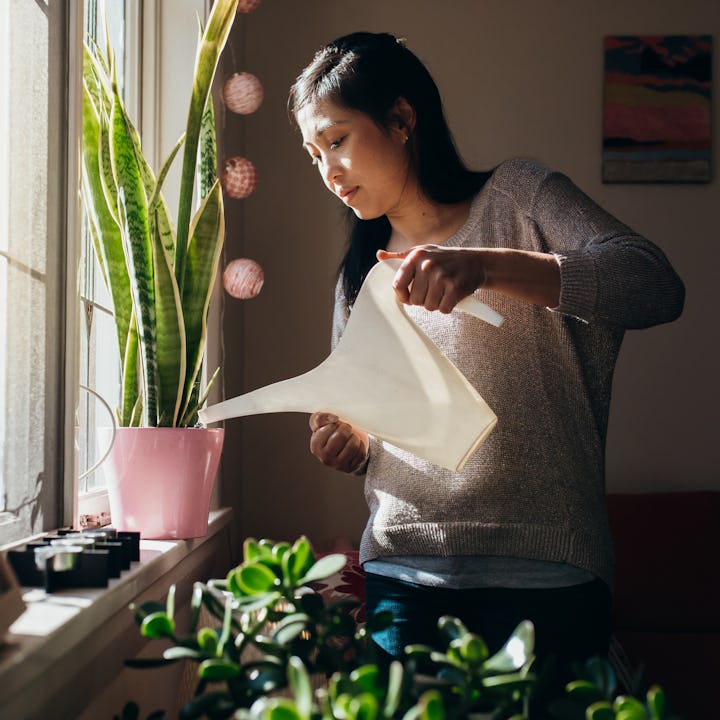5 Houseplants That Thrive On Neglect
Because you have enough living things to care for.

Let's be honest: The houseplant trend is aesthetically pleasing, but it can be a lot of work. Busy parents already have enough things to care for, so adding high-maintenance plants that require a gentle misting every day (or more) is just not realistic.
But don't abandon hope of having some green vibes in your home — if you dream of having plant bebes like the rest of your Instagram feed, it's still possible. The trick is to find varieties that can handle neglect as much as that pair of heels in the back of your closet. Here are five.
1. Snake Plant
The Sanseveria should be at the top of any brown thumb's plant list. Also known as snake plant, Devil's tongue, and mother-in-law's tongue (rude!), there are several varieties of snake plants. So, you can have a little diversity on your plant shelf while keeping the same routine. The most commonly seen is Sansevieria trifasciata 'Laurentii,' which has long pointed leaves of a deep green and white pattern with bright yellow stripes vertically up the side. The single-leaved Sansevieria masoniana or whale-fin Sanseveria can be a dramatic statement plant and just as easy to care for.
Snake plants can handle a range from low light to bright, indirect light (avoid direct sunlight). They don't need a ton of water — aim to water once every couple of weeks during the active growth period (spring and summer) and less in the winter. They don't like to be fertilized, and they don't need humidity. They do need well-draining soil. Parents should know that snake plants can be toxic if ingested, causing stomach distress, vomiting, and diarrhea if eaten. In other words, keep them out of reach of kids and pets.
2. Houseleek
If Trader Joe's has taught us anything, it's that the world loves succulents — and Sempervivum are the reigning queens of the family. Also called "hen and chicks," they grow in a rosette pattern with small pups that sprout out around them. There are many varieties, including deep rusty reds to chartreuse green. Favorites include Sempervivum 'Red Lion' and Sempervivum tectoru, aka common houseleek.
The trick to growing your houseleek is a bit of neglect. They don't like to be fussed over, and more than anything, they don't like to be overwatered. Watering once a week is sufficient, and even less in the winter. They like bright light and can tolerate some morning sun. Be sure the potting soil has adequate drainage.
3. ZZ Plant
Zamioculcas zamiifolia, more commonly known as the ZZ plant, is popular not only for its glossy leaves and unique structure but also for being incredibly low maintenance. Like snake plants, they can tolerate various light situations, from low to bright, indirect light. They don't need excess humidity or misting and only need to be watered occasionally — once every two weeks during the growing season, less in the winter.
Ensure they have quick-draining soil and fertilize with a diluted water-soluble solution once a month during the active growth (spring and summer). The only downside of these plants is that they are toxic, so keep them out of reach of pets and kids. Keep an eye out for the black ZZ plant, Zamioculcas zamiifolia 'Raven,' named for its glossy near-black leaves. Shop for ZZ plants here.
4. Burro's Tail Sedum
If you want a trailing plant that is lovely but still low care, look no further than the donkey tail or burro's tail sedum (Sedum morganianum). Like other succulents, it requires little water, so watering every two weeks or so is sufficient during the growing season. If you notice the leaves looking less plump, you can increase water slightly, but be sure to let the soil dry out completely in between. Overwatering will kill it.
Burro's tail like bright shade or partial sun, so they do great in a sunny window. Bright indirect light is also fine. They also need very little fertilizer. Just be sure the soil is well-draining. These are non-toxic plants.
5. Cast-Iron Plant
As the name might imply, the cast-iron plant (Aspidistra elatior) is tough as nails. It can tolerate a variety of light conditions, including low light. Bright, indirect light is also OK; just avoid direct sunlight. Unlike many other houseplants, the cast-iron plant can also handle temperature fluctuations, including cooler indoor temperatures. It requires regular watering, but if it is in lower light and cooler temperatures, water it less. Be sure to let it dry out completely in between waterings.
The cast-iron plant needs only occasional fertilizing — once or twice a year with a water-soluble solution is sufficient. It grows very slowly, which can be a big perk for plant parents who'd rather not deal with transplanting frequently. Look for A. elatior' Milky Way,' which has deep green leaves speckled with lighter green and yellow. This plant is non-toxic. Shop for one here.